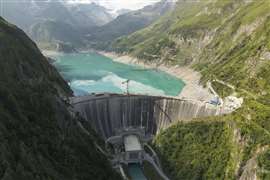Global reservoirs struggling to meet water demands despite construction boom
23 June 2023
A recent report funded by NASA and conducted by Texas A&M University reveals that the construction boom and the development of new dams are insufficient to alleviate the mounting pressure on global water supplies.
 Despite an increase in storage capacity due to the construction of new reservoirs, global reservoir volumes have consistently declined over the past two decades (Photo: AdobeStock)
Despite an increase in storage capacity due to the construction of new reservoirs, global reservoir volumes have consistently declined over the past two decades (Photo: AdobeStock)
Despite an increase in storage capacity due to the construction of new reservoirs, global reservoir volumes have consistently declined over the past two decades.
Utilizing satellite data, the researchers, led by Dr. Huilin Gao, an associate professor at Texas A&M University, employed a novel approach to estimate the storage variations of 7,245 reservoirs worldwide from 1999 to 2018.
The report, published in Nature Communications, highlights that surface water reservoirs are increasingly relied upon to meet the rising demands driven by growing populations and climate change. However, the global availability of water in these reservoirs has not been adequately quantified, according to the researchers.
Dr. Huilin Gao, the lead author of the report, emphasizes the role of climate change as a critical factor in reducing reservoir efficiency, but also acknowledges the impact of increasing water demand. Even if temperatures stabilize, rising demand and ongoing construction are expected to persist.
Based on the research, projected trends indicate that water runoff will continue to decline alongside rising water demand, potentially leading to significant implications for water supplies.
The findings emphasize that constructing new reservoirs alone is not sufficient to address future water demands.
The decline in reservoir storage is particularly pronounced in South Asia, Africa, and South America. Although efforts have been made to build new reservoirs, the data indicates that they are falling short of anticipated filling levels.
South America and Africa, in particular, have experienced significant declines due to the growing populations and subsequent surge in water demand.
Elsewhere, reservoirs in regions such as North America and Europe show upward trends in reaching maximum capacity. High-latitude regions like the Great Lakes and Siberia have larger storage capacities due to lower population densities and less human activity.
Dr. Yao Li, a former postdoctoral researcher at Texas A&M University and currently a professor at the School of Geographical Sciences at Southwest University, highlights the need to reassess the socio-economic benefits of constructing new reservoirs and addresses the tension between increasing water demand and declining availability in developing countries.
STAY CONNECTED


Receive the information you need when you need it through our world-leading magazines, newsletters and daily briefings.
CONNECT WITH THE TEAM











